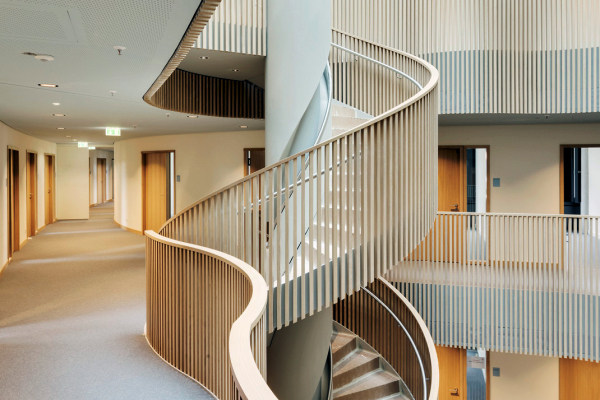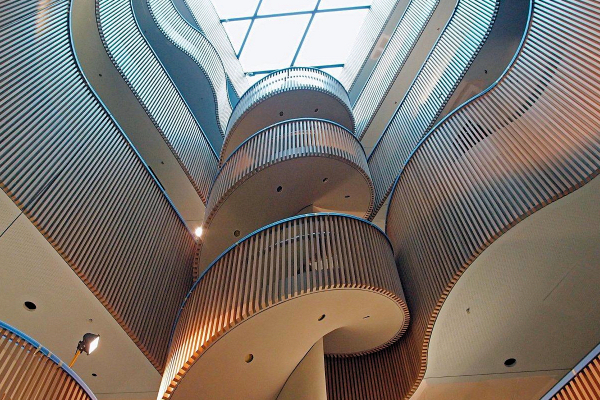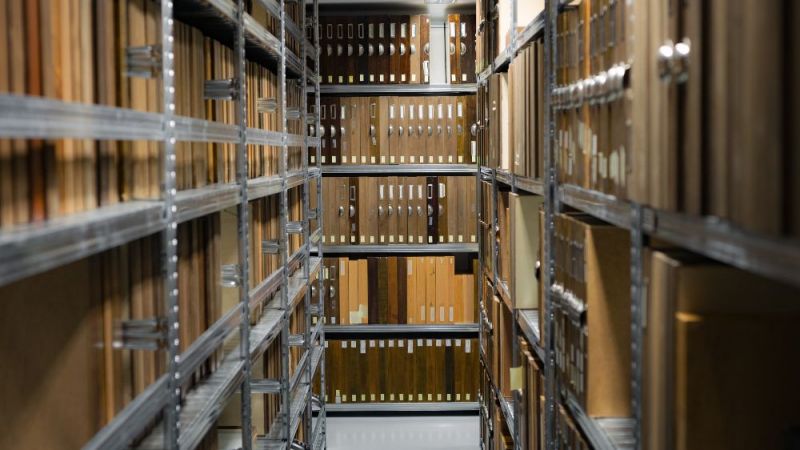
IBA Hamburg
Excellent architecture with a sustainability certificate
The new building for the Hamburg Department for Urban Development and the Environment, which was completed in 2013, forms part of the International Building Exhibition (IBA) in Hamburg. The exemplary building complex is designed to be energy-efficient, sustainable and at the same time cost-effective. The scheme’s very compact form, with excellent thermal and solar protection and optimally transparent facades, is aimed at achieving a primary energy demand of only 60 kilowatt hours per square metre per year. The building is currently being scientifically monitored.
The building design emerged from a competition held by Sprinkenhof GmbH from Hamburg as the developer in cooperation with IBA Hamburg GmbH. The site is located in Hamburg-Wilhelmsburg and is a central component of the “New Central Wilhelmsburg” plan, which was created on the basis of the “New Central Wilhelmsburg 2013plus Master Plan”. As a municipal service provider, Sprinkenhof GmbH has taken over the realisation of the project following the competition process. For the design phases as far as the planning application, the design partners were the winning consortium from the competitive process comprising Sauerbruch Hutton Architects from Berlin and Innius RR GmbH from Rosbach (formerly R+R Reuter Rührgartner Planungsgesellschaft für Gebäudetechnik mbH), while the Obermeyer Planen + Beraten GmbH structural engineering company was responsible for realising the detailed planning.
Research focus
The new building will undergo intensive scientific monitoring during the first few years following the commissioning phase. A review of the energy efficiency criteria and the development of an optimisation concept are key objectives of the scientific monitoring. The parallel experiments on a demonstration system at the Institute of Thermo-Fluid Dynamics and Applied Thermodynamics at Hamburg University of Technology (TUHH) also enable concepts for needs-based air-conditioning to be developed and transferred to the new building on reaching maturity. Modelling the building energy system enables the influence of different balance boundaries on the energy and emission characteristic values to be evaluated using actual measurement data.
A sub-project carried out by the solidar Planungswerkstatt office in Berlin is concerned with developing a sub-module for an “Energy & Comfort” user interaction system. In conjunction with the occupants, the intention is to identify energy cost savings and comfort improvements in the building operation and implement them solely through measures not requiring capital investments.
Building concept
Almost 200 metres in length, the building meanders through the new urban district and, with its almost organic shape and striking colours, is intended to symbolise a new era in the south of Hamburg. The new-build scheme, which was completed in 2013, is also the largest construction project at IBA Hamburg! With thirteen storeys, the main tower of the curved new building is 54 metres in height. Two undulating, five-storey wings extend outwards from the tower. Colourful bands made of ceramic panels are fixed to the dark aluminium facade elements: the twenty different colours give the building a striking patchwork appearance. At the same time the facade and glazing have excellent thermal protection.
A curved structure, which stands out with its flowing contours and colours, rests on a rectilinear plinth that defines the edge along Neuenfelder Strasse. The rhythmic pattern of the individual blocks on the plinth is continued in the interior spaces with sunlit atriums in each building section. The atria provide the centre of each of the seven “blocks” that make up the two elongated, low-rise wings, and function as central spaces connecting all office floors. They divide the large office areas and provide lighting to the circulation spaces. The curved building contour results in a sequence of different spatial situations in which the wide, day-lit atriums alternate with the more enclosed, interior corridors. Each atrium is linked to a central core that contains the staircase, lift and ancillary spaces (sanitary rooms, plant rooms, storage space and archives). The corridors and cores are further differentiated through the use of colour. The offices are positioned around the core and atrium. The biaxial individual offices generally have a width of 2.5 metres and a depth of 5.1 metres.
Energy concept
The building envelope has consistent thermal protection as well as an optimised ratio between the opaque and transparent areas. The building shape and atria enable considerable natural light to be used. Considerable indoor comfort with low energy requirements is ensured by the efficient heat recovery used by the ventilation systems, the external solar shading, the differentiated ventilation concept with the option of night-time cooling via air vents in the facade, as well as the heating and free cooling via thermally activated ceilings. In addition to the structural and building services components, the energy concept also relies on the active participation of the occupants in order to utilise the building’s energy savings potential as much as possible.
An essential part of the supply concept is the use of renewable geothermal heat available on the site via energy piles in the building’s foundations and heat pumps. The electrical energy required to operate the heat pumps is procured as green electricity via the general electricity grid in accordance with the City of Hamburg’s supply contract. To cover peak demand and domestic hot water heating, local heating produced from renewables is supplied by combined heat and power generation run by the municipal utility, Hamburg Energie GmbH.
19.11.2021





































